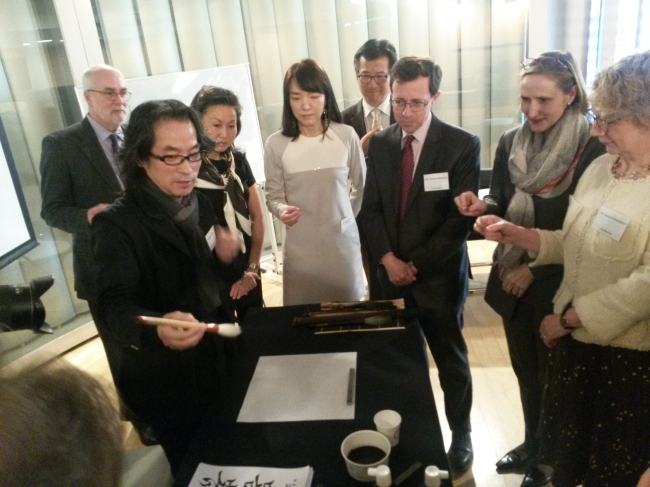
A handful of foreign ambassadors got a taste of “Seoye,” the art of Korean calligraphy, during the Corea Image Communication Institute’s fifth meet-up this session at Institut Francais on Tuesday.
Seoye is an art form that combines the potency of written language with the emotional immediacy of a picture, and dates back to as early as the seventh century on the Korean Peninsula.
The envoys ― French Ambassador Jerome Pasquier, Austrian Ambassador Elisabeth Bertagnoli, Irish Ambassador Aingeal O’Donoghue and Jordanian Ambassador Omar Al Nahar ― were introduced to the art by one of the country’s most renowned seoye masters, Kang Byung-in.
Kang is an innovator of the ancient art, too. Kang has reconceived seoye for up-to-date and appealing designs, and has leveraged this innovative approach into a wide range of recognizable calligraphy and calligrams for products, including Chamisul soju and logos for TV dramas such as KBS’ “King Sejong” and SBS’ “A Thousand Day’s Promise.”
“I want to show the beauty of Hangeul. Hangeul consists of basic shapes such as triangles, squares and circles. This makes it look like both text and image at once. The shape of the alphabet combines the harmony of nature and human beings,” he said.
Kang rattled off several examples of written words that, in Korean, resemble their meaning. The word “chum,” which means “dance” in English, begins with the consonant “chieut” which resembles a person with outstretched arms and legs.
(ephilip2011@heraldcorp.com)
Seoye is an art form that combines the potency of written language with the emotional immediacy of a picture, and dates back to as early as the seventh century on the Korean Peninsula.
The envoys ― French Ambassador Jerome Pasquier, Austrian Ambassador Elisabeth Bertagnoli, Irish Ambassador Aingeal O’Donoghue and Jordanian Ambassador Omar Al Nahar ― were introduced to the art by one of the country’s most renowned seoye masters, Kang Byung-in.
Kang is an innovator of the ancient art, too. Kang has reconceived seoye for up-to-date and appealing designs, and has leveraged this innovative approach into a wide range of recognizable calligraphy and calligrams for products, including Chamisul soju and logos for TV dramas such as KBS’ “King Sejong” and SBS’ “A Thousand Day’s Promise.”
“I want to show the beauty of Hangeul. Hangeul consists of basic shapes such as triangles, squares and circles. This makes it look like both text and image at once. The shape of the alphabet combines the harmony of nature and human beings,” he said.
Kang rattled off several examples of written words that, in Korean, resemble their meaning. The word “chum,” which means “dance” in English, begins with the consonant “chieut” which resembles a person with outstretched arms and legs.
(ephilip2011@heraldcorp.com)
-
Articles by Korea Herald




![[Herald Interview] 'Amid aging population, Korea to invite more young professionals from overseas'](http://res.heraldm.com/phpwas/restmb_idxmake.php?idx=644&simg=/content/image/2024/04/24/20240424050844_0.jpg&u=20240424200058)















![[Today’s K-pop] Kep1er to disband after 2 1/2 years: report](http://res.heraldm.com/phpwas/restmb_idxmake.php?idx=642&simg=/content/image/2024/04/25/20240425050792_0.jpg&u=)